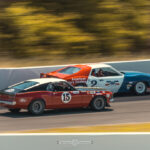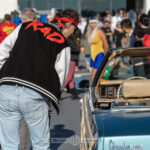
Event Report – Bugattis Gather at Lime Rock Historics 2018

Bugatti clubs all over the world use their cars vigorously when they convene. Rallies of prewar French cars have been crisscrossing continents since before their values or appearance raised eyebrows. Decades of appreciation may have taken the most unique and expensive examples off the roads but the comparatively affordable touring cars still get shipped across oceans and re-rebuilt as necessary. These caravans sometimes begin and end at racetracks where owners of Grand Prix racers push their cars nail-bitingly close to the limits that Pierre Veyron and Albert Divo explored in the ’20s and ’30s. The 2018 International Bugatti Rally upheld all of these traditions by beginning at the 36th Lime Rock Historics Festival where Bugatti had been named the featured marque of the year. After three days of wheel to wheel Grand Prix racing the largest ever gathering of Bugattis in North America would continue on to Saratoga, NY and set up headquarters from which to embark on a week of trips all over the Northeast.

My clan – Famiglia Cesari – has been involved in the Bugatti scene since my grandfather began importing the cars as a college hustle in the 1950s. The automotive gene cascaded through ensuing generations and established a constant involvement with motors for the entire family. It was never in doubt that we would reunite for Historics Festival. The event brought both immediate and remote family together from sea to shining sea. We were all happy for the rare reunion and enthusiastic for the cars but there were subtle differences in our excitement. For my grandfather and parents it was largely a social occasion; a Bugatti rally is a semi-annual meeting of friends from around the country to share a common passion. For my siblings it was primarily a familial event, both having missed some holidays on the opposite coast for the last few years. For myself it was an endearing reunion but the automotive aspect was the rule not the exception; about every weekend during the tropical Michigan months I attend at least one car event. Rarely as well-stocked as Lime Rock’s vintage weekend but similar in kind. What made this weekend unusual was one piece of cargo; an old but trusty Canon 70D and a parcel of lenses and filters that a friend had lent me after her recent upgrade.
Historic Festival no. 36 wasn’t entirely centered around the Molsheim marque, despite some of the Bugattista’s assumptions. The northeastern vintage racing community was out in full force and ranging from enthusiastic collectors to semi-professional teams campaigning for ‘gentlemen driver’ benefactors. Friday and Saturday opened the weekend with a salvo of races. The classes might have been arranged by a composer instead of a sanctioning body such was the harmony the combinations created. Porsche brass trumpeted over Chevrolet percussion before both bowed to the staccato of a section of Ford Kent motors in Formula cars. Especially deft drivers sawed the steering wheels of Bugattis to harmonize skinny squealing tires with the treble whine of superchargers. Sunday ushered a quiet back to the Connecticut valley, an intermission in the din obligated by a truce negotiated between Lime Rock and the surrounding residents decades ago that allowed for a Concours show. The racing returned and crescendoed to a podium finale on Monday.

I began my weekend much more timidly than the racing. A somewhat hurried text message to the owner of the Canon set the precedent: ‘Quick, which of your lenses should I walk around with?’ I was glancing between a 1974 French Blue Alfa Romeo GTV 2000 and a box of industrial-looking, gnurled black cylinders. I’d operated the former before, the latter was unfamiliar. I took a gamble on the 35mm f2 lens; fairytales and Mario Kart concurred that the ‘mama bear’ middle option would be the safest. My erstwhile coach later confirmed this for me with a few other juicy tips for acceptable photographs: apply the circular polarizer filter and spin to taste, ISO low, aperture as big as it’d go. I left the camera in aperture priority mode for the weekend entirely on accident. It was set there out of the box and all I knew was that when I changed that dial my shots were wildly over exposed. I kept the camera in manual focus mode for the first day because I had a vague conception that auto focus would be “cheating” and I would never learn the art with such a crutch. Meanwhile the camera chose shutter speed and I blithely snapped away, unaware of all that I didn’t know.

The dominant origin of the weekend was largely British despite the French feature; a trio of Jaguars, a collection of Lotuses, and the requisite smattering of MGs and Austin Healeys graced the paddock with the friendly Anglo sounds of tractor engines and feeble Lucas starter motors. The Italians volleyed back with respectful force and offered up a handful of Alfas, Lancias, and the occasional Fiat warmed over by Abarth. The racing cars were separated into two basecamps. The A paddock was full of large trailers with words like ‘Classic Car Services’ and 1-800 numbers on the side. Rented event tents, staff of professional mechanics, and golf carts filled the rest of the pavement. The slightly more pedestrian B paddock had 10′ x 10′ pop up tents, swap meet tables, and owners wrenching between sessions. There was yet a third class of cars not intended for racing who waited patiently in the infield for the Sunday Concours show. The diversity of show cars stunned with nearly every era of BMW, rare Zagatos, Lancia rally cars, motorcycles, and hot rods all on display.
The selection overexcited my shutter and outshone even the glaring sun. I was seeing familiar forms in new light; cars at which I had gazed intently in the past now required new analysis. I strove to capture what I had long loved about their shapely sheet metal and wanted to find the perspective that conveyed my passion. Reviewing the photos in the following weeks tallied far too many shot from eye level and poorly exposed as well but I was so enthralled at the time I truly felt I was seeing the cars from new angles. My past hesitation to advance my photography beyond quick iPhone snaps was out of concern that it would diminish the automotive aspect of the experience. These events were often the highlights of my summers, time with friends and sharing excitement over our favorite cars. During my weekend at Lime Rock I quickly learned that car shows with a camera in hand and mission in mind were different but just as enjoyable. Concerns allayed, I snapped away.
Fortunately, I had muddled through enough mistakes by Sunday to perform slightly better during the concourse. With racing on hiatus the track was available for a variety of vehicles that defied categorization. A Fabulous Hudson Hornet replica could be found within yards of a Lamborghini-engined Bizzarrini roadster. A patina’d 1959 Impala low rider motivated by a Lexus IUZ V8 stared at a resolute Volvo Amazon wagon. In the de facto youngtimer section a lone Mercedes 190E 2.3-16 Evo II faced down a trio of BMW E30 M3s archrivals. Two Alfa Romeo Zagatos bookended a golden age for both brands: a Giulietta SZ Sprint Zagato and the more controversial Junior Zagato from the early ’70s. Reigning over these varied subjects were the undisputed king and queen of the weekend: the brawny 1937 Le Mans-winning Bugatti Type 57G “Tank”, the lithe 1936 Bugatti Type 57SC Atlantic, their court of Type 37As, 35Bs, 57s, and many more of Ettore’s creations.
The total count of Bugattis for the weekend was around 70!

Monday brought a slowing of activity to the valley. The racing continued for drivers to clinch their class winning finishes. The Bugatti contingent packed up and drove north to begin a week of private tours of famous collections, scenic drives through upstate NY, and undoubtedly sumptuous dinners and wine. My family had struggled with mechanical issues on our cars but spirits had been unaffected in light of the rare full reunion. My flamenco tempo of shutter clicks had slowed as I finally felt I might have captured most of the event (I hadn’t). After a hesitant and regretful goodbye to both family and racecars, I threw my gear in my truck and started the long drive back to Michigan. My mental and digital memory was full of images and I had a new hobby to reflect and ponder on for the next 12 hours of highway.

In the age of Instagram, car shows are available the world over by hashtag. Events like Goodwood Revival and Festival of Speed, Monterey Car Week and Pebble Beach, or even more targeted shows like Radwood or Luftgekühlt compete for the online attention of thousands or millions more than their paltry hundreds of attendants. Meanwhile the local meets like Irvine or Katie’s Cars and Coffee now have the platform to become the phenomenons that they have. After photographing an event I can see why: it’s intoxicating to share these fabulous machines with the world! But this hyper-globalization may have de-emphasized the quiet regional shows and distracted us from finding the amazing cars tucked away in every corner of this country and others. Events like Lime Rock’s Historic Festival bring them out and even with this new hobby I have to remind myself that Instagram can’t compete with seeing them turn a wheel in anger.
But follow me @merriman.industries anyway!












Mr. Cesari, can you solve this Bugatti mystery for me and my friends?
I have heard that the iconic Bugatti radiator is shaped like a horseshoe based on Ettore’s love for horses, the notion of “Pur Sang”, as in pure blood / thoroughbreds, and his design as beauty in motion, and so on.
BUT I have also heard that the early Bugatti radiator is shaped like the simplest and most functional form in nature: an egg. Which would make sense based on Ettore’s philosophy of “design for function and form will follow.” Looking at the earliest Type 13 / Brescia radiator bears up this theory.
So which came first: the horseshoe or the egg?